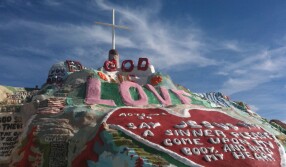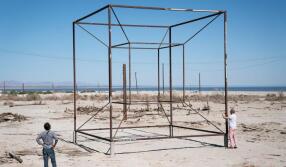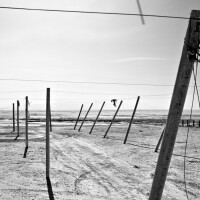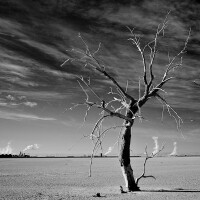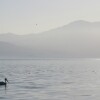Six Best Places to Start Exploring the Salton Sea

Union Bank is a proud sponsor of Lost LA. 

The Salton Sea started as a dry lake, of which there are many in Southern California. As an empty basin, it seemed like a good place to collect the runoff of an overflowing Colorado River. After a series of man-made historic events — such as canal-digging, reservoir-building, irrigation, and other agricultural developments — the sea kept getting saltier and its shores kept fluctuating.
It was meant to be a temporary body of water that would eventually evaporate, but it never did. By the 1950s, people realized the salinity of the water caused it to be more buoyant, making it one of the fastest bodies of water to go boating on. Hollywood celebrities flocked here to visit its shores and to go boating, camping, and even fishing — thanks to some ocean-dwelling fish being introduced to the sea.
But in the end, the Salton Sea turned out to be an engineering disaster, and everything went horribly wrong.
Nowadays, it’s not easy to establish a relationship with the people of the sea and the sea itself and everything it’s overtaken. It has drowned trucks, docks, trailers, power lines, birds and fish. Fish are still dying and continue to be spat out by the sea.
Over time, garbage pickers, photographers, vandals, and curious tourists have disturbed these abandonments, so they're not completely frozen in time. The once-popular and glamorous resort-town image is now shattered and scattered everywhere.
As you try to piece together the habits and lifestyles of what seems like a lost, modern society that’s vanished from the earth, you might feel like a future archaeologist. But instead of arrowheads and wall-markings, you would find golf balls, plastic containers, mattresses, and an old vacuum.
You could find yourself driving in circles in a maze of unpaved roads with no visible buildings.
To embark on a treasure hunt in this land and sea of misfits, misunderstandings, and low-desert heat, means you’re certain to find a lost world worth getting to know. Here are the six best places to begin your journey.
1. Bombay Beach

Just east of the last road in Bombay Beach, the sand rises up in high banks accessible through only two roads — one that appears impassible with a "Beach Closed" sign, and another that’s paved with a dangling chain swept to the side, allowing for easy entry. As you rise over the crest of the bank, you will finally see what you were really looking for: the land of sunken trailers — a jackpot of decayed sites prime for photography. This is the area that had been flooded in the 1970s by a combination of unusual storms and aggressive irrigation runoff. Several of the Salton Sea’s beach towns have been subject to flooding over the years, but at Bombay Beach, the floods resulted in mass destruction of biblical proportions. When the Salton Sea has swelled, Bombay Beach has suffered the most.
The actual beach of this town comes off like a graveyard — by far the most lifeless place you’ll find in the entire Salton Sea area. The actual town of Bombay Beach is resilient, and its denizens have a newfound vitality. Take in a movie at the Bombay Beach Drive-In, a permanent fixture of the Bombay Beach Biennale art event that has taken place each year since 2016. Explore public art, created by and gifted to Bombay Beach by Kenny Scharf. Visit the library of banned books. Each biennale contributes additional attractions to the town, many of which stay in place and can be visited throughout the year. And when you’re done and have worked up an appetite and thirst, socialize with the locals at the Ski Inn or the local American Legion, the only two places where you can get a drink and a patty melt or a steak on that side of the sea.
2. North Shore Beach and Yacht Club
Turn off Highway 111 onto Marina Drive, and the bright yellow façade of the restored North Shore Yacht Club will take your breath away. The restoration preserved many of Albert Frey's original architectural features for the boat club and marina, including the nautical portholes and curved upper level (though the hourglass-shaped pool on the seaside of the building has been removed). It has attracted the likes of the Beach Boys and the Marx Brothers. Now, this gorgeous building is an anomaly compared to its surroundings, which include an abandoned bait and tackle shop.
For a short period of time upon its grand reopening in 2010, the former North Shore Yacht Club housed the Salton Sea History Museum and its collection of historic photos and artifacts, but it has since permanently closed. Now, the space is primarily used as a community center for locals, run by Riverside County. There are after-school programs, fitness classes, and boating programs for kids and adults alike, run by the non-profit organization SEAthletes. It’s also a good spot to have a look at what the sea might’ve been like 50 or 60 years ago.

3. Sonny Bono Salton Sea National Wildlife Refuge
We might consider the Salton Sea a ghost town, or a watery wasteland, but that's not quite accurate. The sea is so huge that several towns comprise its surrounding area, and it's still considered a significant wildlife habitat by the U.S. Fish and Wildlife Service. At the southern tip of the Salton Sea, there's the Sonny Bono National Wildlife Refuge, 32,766 acres that were designated a sanctuary and breeding ground for wildlife all the way back in 1930. The refuge was renamed in 1998 in honor of the 1960s pop star, Palm Springs mayor, and California congressman Sonny Bono. The sea has diminished in size since then, and its shores have morphed. In 2017, irrigation waters were diverted into the sea to mitigate a potential dust problem.
This federally managed site struggles as its shoreline recedes and the habitat for a number of birds, fish, and invertebrates disappears. For eons, the Salton Sea has been an important bird migration spot along the Pacific Flyway, but the birds haven't been coming in droves as much as before — despite the fresh water that's pumped in and the five man-made "nursery islands" that were installed to provide a safe nesting place. Still, you might see a Black Skimmer, eared grebe, or black-necked stilt here or there. And the refuge includes a small, inactive volcano surrounded by obsidian, called Rock Hill, which you can climb and get a good birds-eye view of what’s left of the sea. Admission and parking are both free, and no permits are required for hiking or wildlife viewing.
4. Salton Sea State Recreation Area
The one thing that’s most forbidden at the Salton Sea isn’t exploring the beautiful decay. It’s going in the water. Rampant rumors have reported of its toxicity from irrigation runoff, high salinity (even saltier than the Pacific Ocean), and an uninhabitability even to the fish that swim in it. But many of the local officials and residents insist on its safety, even going so far as to launch a boat, catch the tilapia (and eat them), and take a dip. If you’re not afraid of a little salt, there is an area of the Salton Sea that is open for fishing, kayaking, and swimming — and that’s at the Salton Sea State Recreation Area on the eastern shore.
Because the sea is so salty, it’s both buoyant and fast — which explains the boat races that used to occur when the area was considered a “Desert Riviera.” In terms of safety, the water quality is of less concern than the wind, which can kick up and make the surface of the sea surprisingly choppy. You may even feel as though you’re being pulled by tidal forces. Seabirds are overhead, dive-bombing the water to feed on its fish, bobbing up and down through the sea's surface, startlingly close to the humans they’ve learned to share the sea with. The cries of the birds intermingle with the rattle of freight from the nearby railroad tracks. Beginner programs with the Sea and Desert Interpretive Association have ceased — and the sea is receding — so your best option is to bring your own kayak and launch it behind the visitor’s center. There is a fee for parking, and overnight campsites are available by advance reservation October through May.

5. Dos Palmas Preserve
You might have to keep going back to the Salton Sea to discover the treasure of the Dos Palmas Preserve. East of the sea, where the pavement ends and a dirt road takes you along the towering power lines, you’ll find the Dos Palmas Oasis (literally an oasis of two palm trees — at least when it was named in the 1800s), an adobe ranch house, and a hiking trail that follows the San Andreas Fault to a lush palm grove. In fact, this Bureau of Land Management nature preserve wouldn’t even exist, were it not for seismic activity having tapped into artesian springs and forming ponds that are now also fed by irrigation run-off. And that means not only that there are a lot more fan palms there now, but that they continue to grow and multiply.
In these 1400 acres — more than 110 feet below sea level — you’ll find a unique habitat that shelters many rare species of birds, plants, and fish — including the positively prehistoric desert pupfish, which dates back to more than 11,000 years ago. Few know it’s there, though it’s been protected since it was dedicated as a preserve in 1990. That means you won’t be fighting any crowds to explore or photograph this under-the-radar natural site, which you have to see to believe.
6. International Banana Museum
I guess you'd expect to find a wacky collection of tropical fruit out in the desert. But while the area surrounding the Salton Sea is generally dominated by palm date groves and offerings of date shakes, there's only one place devoted to the fruit that’s shaped like a smile: the International Banana Museum. Just look for the bright yellow robot banana (a creation of outsider artist Kenny Irwin of Robolights fame), which will welcome you to the world's largest collection devoted to the banana (or, any one fruit, for that matter).
There, you can have your pick of a banana sundae, a banana shake, or banana bread. And you'll be in good company with other banana lovers and every kind of banana-fana-fo-fana you can imagine — from Chiquita and Dole to bananas in disguise, banana splits, and more. There are plenty of opportunities to monkey around at the Banana Museum, but the "top banana" here, of course, is the fruit. If it's not the most a-peeling destination in the world, it certainly is so along the eastern shore of the Salton Sea. The museum’s current iteration opened in 2012, and business is booming. For a small admission fee, you can explore over 20,000 banana-related items, some of which are for sale. And if you buy something, you’ll get your ticket price refunded. Call for seasonal hours, especially in the summer.
Bonus: Salvation Mountain

Mountains surround the Salton Sea — the Chocolate Mountains ridge to the east and the Borrego Mountains range to the west. But there’s just one peak that draws visitors from around the world to the Salton Sea area: Salvation Mountain. Technically located in the town of Niland, adjacent to the last “off-grid” community in California (known as Slab City), Salvation Mountain isn’t the work of volcanic or seismic activity. It’s not even geological. Its creator, Leonard Knight, created it from scratch out of trash, papier-mâché, and paint. He assembled boats, trucks, and cars around the mountain to welcome visitors with a declaration: “God Is Love.” And he moved in, living there until he was no longer able to take care of the mountain or himself. Knight died in 2014 at the age of 82, shortly after leaving his life’s work.
Salvation Mountain is open every day of the year from dawn to dusk. There’s no fee for admission or parking, though its onsite caretakers would gladly welcome donations and volunteers.
Top Image: An abandoned speedboat and trailer at the Salton Sea | Katie Noonan
